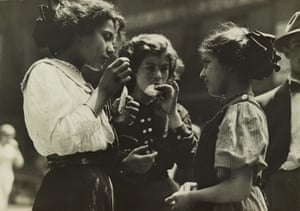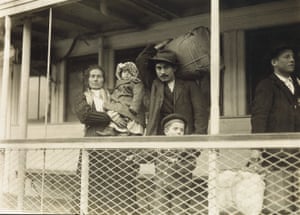The photos that changed America: celebrating the work of Lewis Hine / Las fotos que cambiaron América: celebrando el trabajo de Lewis Hine
When Lewis Hine started photographing children at work in 1908, child labour was pervasive in American industry. His shocking images – from the cotton mills of Carolina to the coal breakers in Pennsylvania – helped bring about child labour laws. Hine was also renowned for his deeply empathetic portraits of immigrants at Ellis Island, and his work documenting construction workers at the Empire State Building
Cuando Lewis Hine comenzó a fotografiar a los niños en el trabajo en 1908, el trabajo infantil era omnipresente en la industria estadounidense. Sus impactantes imágenes -desde las fábricas de algodón de Carolina hasta los carboneros en Pensilvania- contribuyeron a la promulgación de leyes sobre trabajo infantil. Hine también fue reconocido por sus retratos profundamente empáticos de inmigrantes en Ellis Island, y su trabajo que documenta a los trabajadores de la construcción en el Empire State Building.

Pennsylvania coal breakers (breaker boys), 1912
Breaker boys would separate impurities from coal by hand. ‘There is work that profits children, and there is work that brings profit only to employers. The object of employing children is not to train them, but to get high profits from their work,’ said Lewis Hine
Trituradores de carbón de Pensilvania (niños rompedores), 1912
Los niños rompedores separarían las impurezas del carbón a mano. "Hay un trabajo que beneficia a los niños, y hay un trabajo que genera beneficios solo para los empleadores. El objetivo de emplear niños no es entrenarlos, sino obtener grandes ganancias de su trabajo ", dijo Lewis Hine.

Powerhouse mechanic, circa 1921
In one of Hine’s most famous images, he emphasizes machinery and musculature. ‘The visual appeal of the photo is rather direct and stunning,’ Daile Kaplan, vice-president of photographs at Swann galleries, told The Hot Bid. ‘It has harmony, it has visual balance, and at the same time, he positions the worker in a way that he’s controlling the machine. It reflects a new visual vocabulary that addresses the machine age, but it privileges the person with the machine’
Mecánica de gran potencia, hacia 1921
En una de las imágenes más famosas de Hine, él enfatiza la maquinaria y la musculatura. "El atractivo visual de la foto es bastante directo y sorprendente", dijo a The Hot Bid Daile Kaplan, vicepresidente de fotografías en las galerías de Swann. 'Tiene armonía, tiene equilibrio visual y, al mismo tiempo, posiciona al trabajador de una manera que está controlando la máquina. Refleja un nuevo vocabulario visual que aborda la edad de la máquina, pero privilegia a la persona con la máquina '

Derrick and workers on girder, Empire State Building, 1930-31
In Hine’s vertiginous series of photos of the Empire State Building’s construction, he shot men performing perilous tasks perched on beams and hanging from wires. Times’ art critic Ken Johnson once wrote the photographs reflect Hine’s ‘romantic belief in the possibilities of America’
Grúa y trabajadores en la viga, Empire State Building, 1930-31
En la vertiginosa serie de fotos de Hine de la construcción del Empire State Building, él disparó a hombres realizando tareas peligrosas encaramadas en vigas y colgando de cables. El crítico de arte del Times, Ken Johnson, escribió una vez las fotografías que reflejan la "creencia romántica de Hine en las posibilidades de Estados Unidos".

Noon hour in East Side factory district, New York, 1912
Hine’s work centralizing child workers was part and parcel of the progressive ideology of the era, which joined, among others, social workers, labour leaders, suffragists, and teachers in the hopes of bringing about meaningful reform
Hora del mediodía en el distrito fabril de East Side, Nueva York, 1912
El trabajo de Hine de centralizar a los niños trabajadores fue parte integrante de la ideología progresista de la época, que se unió, entre otros, a trabajadores sociales, líderes sindicales, sufragistas y docentes con la esperanza de lograr una reforma significativa.

One of many children working in Carolina cotton mills, 1908
In 1908, Hine was commissioned by the National Child Labour Committee to begin documenting young workers across the country. At the time, children were regularly employed on family farms, but Hine’s photographs brought attention to their work as miners, mill workers, and oyster shuckers, and eventually helped lead to the passage of the Fair Labor Standards Act in 1938
Uno de muchos niños que trabajan en fábricas de algodón de Carolina, 1908
En 1908, Hine recibió el encargo del Comité Nacional de Trabajo Infantil para comenzar a documentar a los jóvenes trabajadores en todo el país. En ese momento, los niños eran empleados regularmente en granjas familiares, pero las fotografías de Hine llamaron la atención sobre su trabajo como mineros, trabajadores de fábricas y ostion shuckers, y finalmente contribuyeron a la aprobación de la Fair Labor Standards Act en 1938.

Italian family in the baggage room, Ellis Island, 1905
Hine is often called a ‘social photographer’, and when he worked at the Ethical Culture School in New York City one of his assignments was to document immigrants arriving at Ellis Island. He hoped the work would make viewers have ‘the same regard for contemporary immigrants as they have for pilgrims who landed at Plymouth Rock’
Facebook Twitter Pinterest
Familia italiana en la sala de equipajes, Ellis Island, 1905
A menudo se lo llama "fotógrafo social", y cuando trabajaba en la Ethical Culture School en Nueva York, una de sus tareas era documentar a los inmigrantes que llegaban a la Isla Ellis. Esperaba que el trabajo hiciera que los espectadores tuvieran "el mismo respeto por los inmigrantes contemporáneos que por los peregrinos que desembarcaron en Plymouth Rock".
Facebook Twitter Pinterest

Italian family on the ferry boat landing at Ellis Island, 1905
Hine photographed immigrants at Ellis Island from 1904 to 1909, taking some 200 photographs in all. The work has drawn comparisons to that of Jacob Riis, the Danish-American social photographer and journalist who chronicled the lives of impoverished people on New York City’s Lower East Side.
Facebook Twitter Pinterest
Familia italiana en el ferry que aterriza en Ellis Island, 1905
Hine fotografió a inmigrantes en Ellis Island de 1904 a 1909, tomando unas 200 fotografías en total. El trabajo se ha comparado con el de Jacob Riis, el fotógrafo y periodista social danés-estadounidense que hizo una crónica de las vidas de las personas empobrecidas en el Lower East Side de la ciudad de Nueva York.
Facebook Twitter Pinterest

Mother and child, Ellis Island (Italian Madonna), circa 1907
Hine’s Ellis Island photographs are often praised for maintaining the integrity of his subjects, shooting them as individuals without exoticizing their pilgrimage
Madre e hijo, Ellis Island (Madonna italiana), alrededor de 1907
Las fotografías de Hine en Ellis Island a menudo son alabadas por mantener la integridad de sus súbditos, disparándoles como individuos sin exotizar su peregrinaje.

Slavic immigrant at Ellis Island, 1907
Hine’s Ellis Island images were shot with a Graflex camera. He often had to overcome language barriers in the process of locating his subjects, finding an isolated place to shoot them, and setting the pose.
Inmigrante eslavo en Ellis Island, 1907
Las imágenes de Hine en Ellis Island se tomaron con una cámara Graflex. A menudo tuvo que superar las barreras del idioma en el proceso de localizar a sus sujetos, encontrar un lugar aislado para fotografiarlos y establecer la pose.

Climbing into America (Ellis Island group), 1908
In Climbing into America, Slavic immigrants assemble on a flight of stairs carrying all that they’d brought with them to the United States. Each figure in the photograph, looking weary and breathless, has in hand a white sheet of paper, likely a registration form of some sort
Escalando hacia América (grupo Ellis Island), 1908
Al escalar hacia América, los inmigrantes eslavos se reúnen en un tramo de escaleras llevando todo lo que trajeron consigo a los Estados Unidos. Cada figura de la fotografía, que parece cansada y sin aliento, tiene en la mano una hoja de papel en blanco, probablemente una forma de registro de algún tipo

Hot day on East Side, New York, circa 1908
The Hine works being auctioned at Swann Galleries come from the personal collection of Isador Sy Seidman, a friend of Hine’s and a lifelong collector of New York City-centric photographs
Día caluroso en East Side, Nueva York, alrededor de 1908
Las obras de Hine que se subastarán en las Galerías Swann provienen de la colección personal de Isador Sy Seidman, amigo de Hine's y coleccionista de fotografías de Nueva York centradas en la vida

Patriarch at Ellis Island, 1905
‘Though Ellis Island was not a new subject for journalism and pictorial representation, Hine’s approach and motivation may have been new,’ wrote Maren Strange of Hine’s social documentary photography, revealing the ways Hine’s work exemplifies the spirit of early 20th-century migration
Patriarca en Ellis Island, 1905
"Aunque Ellis Island no era un tema nuevo para el periodismo y la representación pictórica, el enfoque y la motivación de Hine pueden haber sido nuevos", escribió la fotografía documental social de Maren Strange of Hine, revelando cómo el trabajo de Hine ejemplifica el espíritu de la migración de principios del siglo XX
Icons & Images: Photographs and Photobooks sale is at Swann Galleries in New York on February 15.
Iconos e imágenes: la venta de fotografías y álbumes de fotos se realizará en Swann Galleries en Nueva York el 15 de febrero.
THE GUARDIAN
Comments